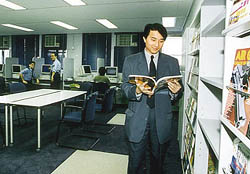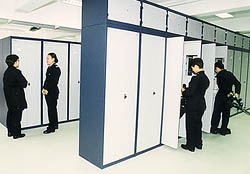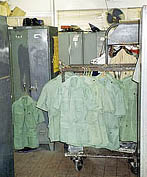



















 Officers making use of the newly created resource room at North Point Station. By 2002 all police stations will boast one |
IN line with the Government's commitment to
upgrading the service provided by the police as well as to police facilities as outlined by the
Chief Executive in his 1998 Policy Address, the North Point Police Station has been used as a
pilot project to identify and evaluate Hong Kong Police customer service improvement
opportunities, with the project's main objective being to maximise this quality service and to
develop a benchmark for its delivery.
The station improvement scheme, based on the North Point Station Pilot Project Ал both in terms of enhanced customer service and improved building redesign-has been extended to, and replicated at, the Sau Mau Ping and Sha Tin Police Stations with all work scheduled to be complete by the end of March. |
|
The plan is to then extend the project to all police stations in the HKSAR for completion by 2002. The project will also encompass operational bases and police posts. Since the beginning of this far-reaching, customer-focused pilot project in October 1997 very tangible results have been achieved and implemented. Nowhere is this more apparent than in the report room at North Point which is in the process of being redesigned in an open, welcoming and user-friendly way. This will provide a facility which is modern, barrier-free, comfortable, while meeting the professional image of the Force and facilitating a positive interaction between police and members of the community. As with the other parts of the project, the interior designers in consultation with junior police officers, members of the public, P & D and Service Quality Wing have designed efficiency into report rooms that facilitate the use of modern technology not only to those working within but to the public as well. "At the same time all officers at the North Point Station including UB, CID, civilians and auxies have gone through a training process in which case scenarios were developed and appropriate exercises carried out to ensure that the police provide the best standard of service possible to the station's users," said CSP Service Quality Wing, Mak Man-poon. "Upgrading the working environment provides better service for the public Ал but also for Force members." This has been especially true with the creation of resource centres and improvements to police station changing rooms, which have been exceedingly well-received by staff at North Point Police Station, as well as at Sau Mau Ping and Sha Tin Police Stations. "In the 1998 Staff Opinion Survey, in terms of working environment, police rated changing rooms as an area of the highest importance, but in terms of actual performance gave changing rooms the lowest ratings, with the majority of officers complaining about their poor conditions. The changing rooms were hot, humid, cluttered, dysfunctional. So it was very clear to us that the situation had to be improved," explained CSP Planning & Development, Dave Thomas." To that end, the redesigned and completely overhauled changing rooms at North Point Police Station will serve as the prototype for all changing rooms in police stations throughout the HKSAR. The rooms are now air conditioned, efficiently laid out, bright and have new purpose-built, modular lockers and benches designed to fit into the space provided. Areas to dry clothing are also available. "I like the new changing rooms very much," says Chan Chi-wah a traffic officer operating out of North Point Police Station. "Before officers would get very sweaty and feel uncomfortable especially during the humid days of summer. As a result, it was very easy to start work in a bad mood, which wasn't very good in terms of interfacing with the public. I feel that the improvements to the changing rooms have gone a long way to improving our attitudes-and that translates into better service to members of the public." Echoing his colleague's remarks, PC Chan Siu-hong also praises the storage capacity of the new lockers: "There's now enough space for everybody. It's a much better environment-comparable to the change rooms you find in a good health club. I've talked to a lot of my colleagues and they all agree that the improvements have had a positive effect on their frame of mind." Said PC Ng Luen-shun: "I think a lot of thought has gone into the design of the lockers. In the past, there was one standard locker. Now there are three types for regular UB officers, CID officers and for auxiliary police." "There's no comparison between this room and the old change rooms," said PC Cheung Hang-luen. "The new facilities are welcomed by all officers using them." Sau Mau Ping WPC Leung Shuk-fong also likes the new changing room. "It's so much better than the old ones. The upgrading made to the toilets and showers are very hygienic." "Another of the objectives of the new changing rooms has been to chose materials to create a professional, clean working environment that's easy to maintain," explained CSP P&D Dave Thomas. "Through the proposals made by interior designers we've also selected the blue and grey colour scheme to present a corporate image which will be applied uniformly throughout all the police stations." The new resource centre was created to provide an area for junior police officers to do private study and discuss their work in comfort-something which had never been included in previous station designs. "At present in police stations JPOs don't have the space for self-study, and they can't easily access reference materials," explained SIP P&D Ivan Lee. "With the resource centres that has all changed. The rooms are very comfortable with computers, Internet, reference systems and reading material. The modular design of the new furniture allows for different setups and an area complete with conference table can be partitioned off with a folding wall to accommodate meeting. So officers can come here alone to conduct research, and prepare statements and cases; or come in groups (work improvement teams, for example) to discuss subjects of interest." Said North Point Police Station PC Andy Razack:"The resource centre is very comfortable and the environment is very good for junior police officers to use on their own, or with colleagues. I come here often-three or four times a week to read the newspaper or to find information. A lot of police officers come here to use the Internet." Sergeant Cheung Ping-kit, who was recently transferred to North Point Station, was pleasantly surprised to see all the improvements: "I' m very impressed with the changes. The new report room, changing room and this resource centre are very positive steps forward. I've been in the Force for many years, but I've never had the opportunity to make use of a resource room like this-such a facility simply did not exist before. I intend to use the room frequently, especially its computers." | |
|
"Indeed," said CSP Thomas, "police report rooms and changing rooms have remained basically the same throughout this century. This project represents a fundamental change. The idea of a well-appointed resource centre for junior police officers in every police station in Hong Kong is almost revolutionary. In terms of progress these improvements bring a very high standard to the Hong Kong Police. So this project is really taking the Force into the next century." |
 
"No comparison!" WPCs enjoying internal quality of service at the new changing room at Sau Mau Ping Police Station. (Right) a typically dysfunctional changing room (soon, thankfully, to be a thing of the past) at TST Police Station |

